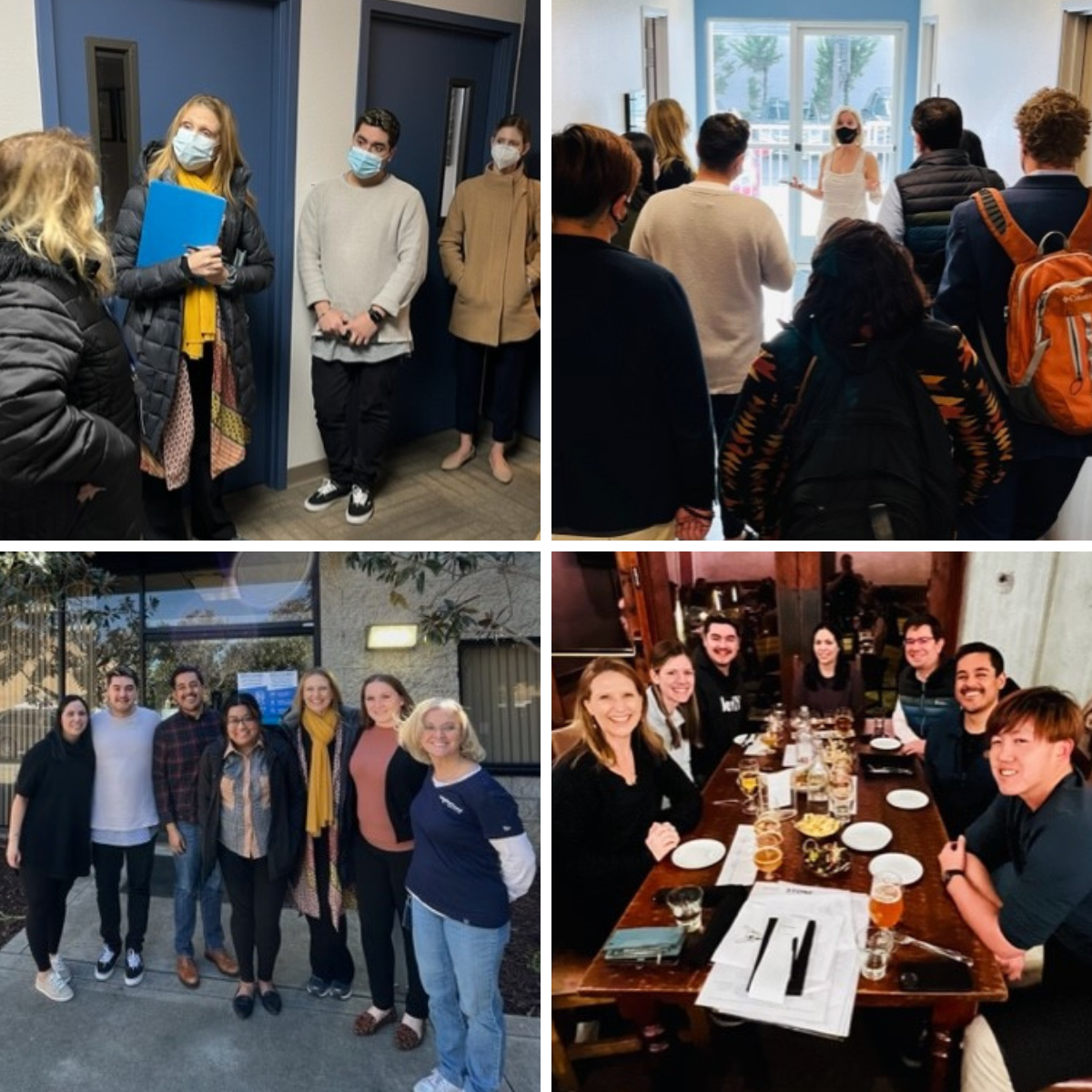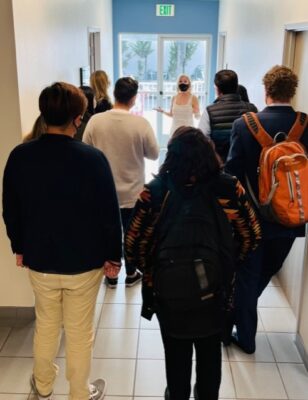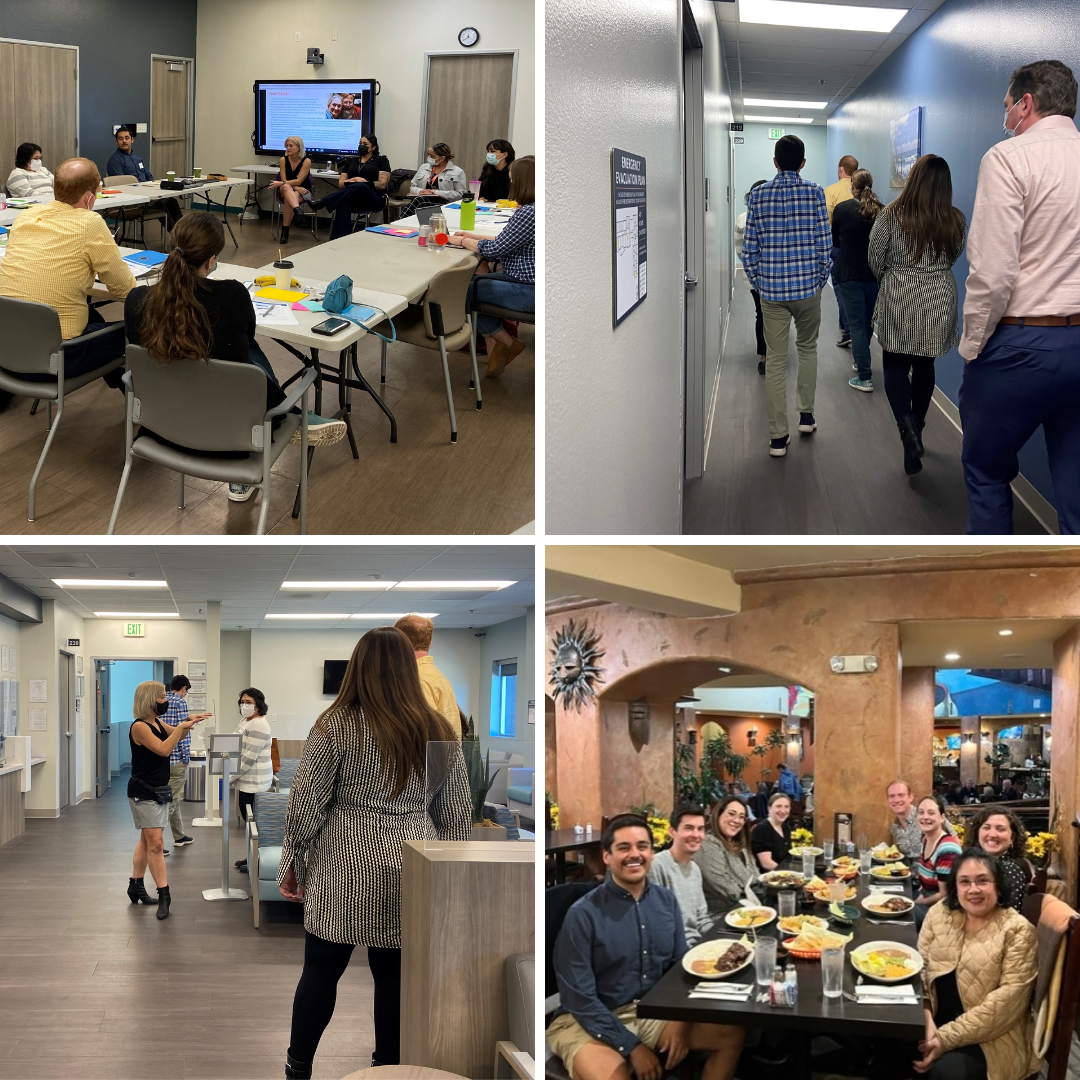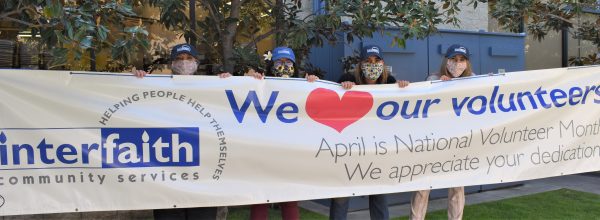Like many cities across the United States, San Diego is contending with widespread homelessness, a surge of deadly drug overdoses and limited resources for treating mental illness — all of which worsened during the pandemic.
CCI partner Neighborhood Healthcare, which serves San Diego and Riverside counties, is working hard to change that picture. After months of being confined to Zoom meetings during the pandemic, participants in our Advancing Behavioral Health Equity in Primary Care (ABHE) program and CCI staff were thrilled to travel to San Diego for a site visit and spend time with the community health organization in person.

Wendi Vierra, Neighborhood’s director of operations for behavioral health, hosted the team on a walk-through of the Ray M. Dickenson Wellness Center and a visit to the health center’s nearby satellite clinic. She and her team also shared their history of developing community partnerships to better serve underinvested communities.
One of the’ ahas’ that really stood out to the ABHE team from the site visit was the importance of Vierra’s role, according to Juan Carlos Piña, a CCI program manager. “She’s not just a director of operations; she’s a director of operations in behavioral health. She has a background in behavioral health and a PhD in psychology. And a lot of the sustained behavioral health integration and equity work in Neighborhood Healthcare is done by design,” thanks to her executive powers and her unique role.
Piña said CCI program participants were brimming with questions for Vierra. “They said ‘it’s such a privilege for you to have those two lens in your role, because a lot of clinics don’t have that,” he said. “Oftentimes when you have a regular director of operations, they might not understand why certain procedures need to be the way they are.” Vierra understands that, he says, “and she has the autonomy and ownership to implement those policies and procedures with that behavioral and equity lens by garnering buy-in from others to implement these policies . And I think that’s part of their secret sauce.”
Merging behavioral and and operations lens with executive-decision-making power has definitely helped Neighborhood become a well-oiled machine, agreed Lydia Zemmali, a CCI senior program coordinator. “Wendi is also a champion of integration,” she said. “She works to make things streamlined. She has a strong mindset around that and is very strategic.” And as ABHE participants have frequently pointed out, it’s hard to have such impact if a clinic or health center doesn’t have a dedicated executive to move forward and sustain the work.
Program participants were especially impressed by the integrated satellite clinic on the main campus of Interfaith Community Services. To help unhoused patients with drug-related health issues, it offers a 50-bed homeless shelter and a recovery and wellness substance use treatment program providing detox, on-site residential treatment and intensive outpatient care, including access to food, employment and housing services.
Neighborhood’s partnership with Interfaith includes a primary care clinic in a building they share with Interfaith case workers. The visit included talks with Filipa Rios, Interfaith’s chief program officer, and Ariana Real, Interfaith case manager, who helped explain the complexity of services and coordination between agencies required in a recent case to rescue and help stabilize a developmentally delayed adult, her baby, and the grandmother.
“They’re giving all kinds of care with a harm reduction lens, and they can do it right there in the building,” said Zemmali. “It was interesting to hear that for certain [services] that a community-based organization offers, the patient needs medical clearances. And without having a primary care clinic right there in the same building, that patient might otherwise not be able to access housing or some other key services.” It reminds everyone that addressing patients’ social needs is a crucial part of their healthcare and healing, she added.
7 Key Takeaways
Look to your community partners for support
The most recent site visit echoed other conversations with Vierra, in which she stressed that Neighborhood’s partnership with Interfaith and other nonprofits was key to meeting patients’ needs outside the clinic walls of San Diego and Riverside counties.
“Our vision is to give people the resources they need to live their best lives,” Vierra said earlier in the pandemic. “We understand we cannot do that alone. We need the expertise of our community-based partners to provide whole person care and provide a solid foundation for wellness.”
Neighborhood’s relationship with Interfaith dates back more than 16 years, when the faith-based nonprofit asked the clinic whether it could take over its behavioral health program. As an in-kind contribution, Neighborhood encouraged Interfaith to stay in its original clinic rent-free. The nonprofit sends clients to the clinic for behavioral health care, while the clinic gives “warm handoffs” to Interfaith for patients seeking food, childcare, housing, employment, disability support, substance use disorder treatment and other services, with the goal being stability and permanent housing.
Build A credible, reliable safety Net
“Everything is about relationships,” Vierra has said. “Building a credible, reliable safety net that wraps around our patient and is non-judgmental, has cultural humility, and is trauma informed…We must include patients’ voices to determine, what, how, and when they receive services from all of this. We are all better together.”
Over the years, the clinic has given out both small and multiyear grants for Interfaith and other community partners. Through strong, personal partnerships with community-based organizations (CBOs), Neighborhood and its nonprofit partners serve more than 112,000 safety net patients a year, 40 percent of whom are monolingual Spanish speakers. They have also helped many unhoused patients move off the streets into permanent housing.
Use data to help guide your decisions
The team was impressed that when looking at social determinants of health, Neighborhood uses data to drive its decision-making, notes CCI Program Director Juliane Tomlin. “They’re using data in their screening to look at which social needs come up the most, and they’re using that data to go out of their way to deepen relationships with partners: ‘Who else is doing this type of work and how can we work together?’” Neighborhood leaders, she said, also use the data to develop new partner relationships if they need to, with Vierra suggesting that leaders “go on dates” with lots of different potential partners to identify common goals.
Ask your patients what they need
Neighborhood is quick to say it has made some mistakes in the area of social needs. “It’s easy for staff and providers to make assumptions about which social determinants of health are the most important to address, and Neighborhood has talked about the times they’ve learned that they actually just need to ask the patient,” said Tomlin. One common assumption is that all unhoused patients would like to be housed as quickly as possible, but Neighborhood learned some were not ready because the housing available was often limited to drug-free individuals.
“That goes into Neighborhood’s harm reduction model, because maybe for [a few] patients, getting housing is not one of their top priorities,” said Tomlin. “Maybe they really need the drugs they’re using to reduce the trauma they’re feeling, and they’re not ready. So really talking to patients and finding out their motivations and what’s important to them was a real learning.”
Develop strategic grant proposals for behavioral health and integration
Program participants were also impressed by Vierra’s prodigious grant-writing, through which she carved out funding for care coordinators and other staff doing work supporting behavioral health integration. “Wendi has been very creative in her grant applications for everything from staff training to space buildout,” Tomlin said. “She builds relationships with everybody through the ‘no wrong door’ approach as well as partnering with community-based organizations.”
Over the years, the clinic has given out both small and multiyear grants for Interfaith and other community partners. By building strong, personal partnerships with community-based organizations (CBOs), Neighborhood Healthcare works with them to remove barriers to accessing health care.
Cultivate a learning mindset
 One of the things the team really loved, said Tomlin, “is that Neighborhood has cultivated a real learning mindset for its entire staff. They’re constantly trying out small tests of change. And as part of their performance reviews, all staffers are asked to come up with two ‘Big & Bright Ideas’ that they think would improve the way they do their work. It’s really beautiful because it is tapping people on the frontlines and helping them grow these skills.”
One of the things the team really loved, said Tomlin, “is that Neighborhood has cultivated a real learning mindset for its entire staff. They’re constantly trying out small tests of change. And as part of their performance reviews, all staffers are asked to come up with two ‘Big & Bright Ideas’ that they think would improve the way they do their work. It’s really beautiful because it is tapping people on the frontlines and helping them grow these skills.”
To achieve equity, eliminate the barriers to health care
If you don’t screen for barriers to health care and connect individuals with essential resources, they may spiral into poverty or remain there, leading to increased mortality rates, according to Vierra. This is even more important during a pandemic, she said, to prevent individuals and families who have lost their financial stability from spiraling.
“Living our best life means that everyone has a fair and just opportunity to be as healthy as possible,” she noted. “This requires removing obstacles to health, such as poverty, discrimination, and their consequences, including powerlessness and lack of access to good jobs with fair pay, quality education and housing, safe environments, and health care. How do we get there? We need to start leveling the field by removing visible and invisible barriers.”
She also gave a shout-out to some key staff and partners — including Dr. Laura Caloca, psychologist; Annamarie Tovar, medical assistant clinical services supervisor; Irma Garcia, behavioral health front office supervisor; and Kayla Ruiz, harm reduction program supervisor. “I am nothing without my amazing team and partners’ team of highly effective and dedicated staff,” she concluded.
Resources
ABHE Site Visit: Overview and Model of Integration. Neighborhood Healthcare.




